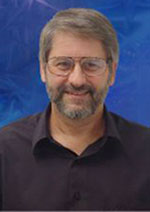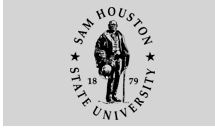SHSU To Work With Univ. Of Vermont

Ted Creighton
|
Sam Houston State University was one of only six universities in the nation
recently selected to participate in a major nation-wide effort.
Through this initiative, led by the University of Vermont, modules of instruction
will be designed to improve public education for students with disabilities and
those considered “at risk” by preparing school principals and superintendents
on ways to address such issues.
SHSU professor Ted Creighton and doctoral student Franci McConnell-Roberts have
been chosen to work with the Institute for Leadership, Disability and Students
Placed at Risk, an institute that is being established this fall at UVM after
having received a $1 million anonymous gift specifically to
initiate the effort.
“The two of us are charged with creating modules of instruction that we
will distribute to all the universities who have principal and superintendent
preparation programs,” Creighton said. “It is an attempt to get at
the leaders, meaning the principals and superintendents of the schools, and help
them understand how they can better design programs, instruction and activities
to help students who we consider to be falling below the surface, or between
the cracks.”
Those modules of instruction will come from an annual dissertation of each student
scholar from the participating universities during the five-year
project.
“Hopefully we are going to get six dissertations annually designed around
helping leaders understand students with disabilities and those at risk of dropping
out or failure of some kind,” he said.
McConnell-Roberts, who is the principal of The Rubicon Academy in The Woodlands,
said she has chosen to explore the topic of collaborative community schools,
which involves bringing different services to a campus, to benefit families with
poor-paying jobs or none at all. Such services include social workers, psychologists,
pediatricians, adult job trainers and placement advisers, legal assistants, tutors,
and adult literacy and parenting specialists,
she said.
“These are all separate agencies or professionals that the parents have
to make appointments with, fill out paper work for, make financial arrangements
with, take time off of work for and so forth; and, therefore, usually end up
not doing it. On top of that, many parents do not hold a job or they have a very
low-level, poor-paying job because of illiteracy problems,” McConnell Roberts
said.
“Needless to say, children trying to grow and achieve in such an environment
have a great deal of difficulty. They become poor learners and quite frequently
discipline problems,” she continued. “This in turn leads to the problem
of finding teachers who want to work in a disadvantaged environment. In other
words, poverty breeds poverty because of the insurmountable walls that inhibit
or prohibit these children and their families from being successful.”
Under the collaborative school program, all of these types of services become
available on the school campus, making it, in essence, “the heartbeat of
the community where all needs are met.
“The school is now the community center of the neighborhood, and open almost
24 hours a day, where the children receive all the educational, health, and emotional
services right on their school campus," she said. "Parents receive training in
literacy and parenting skills and job placement assistance right on the school
campus.
“Student teachers do their in-service training, and hopefully return as
fully certified teachers, on this type of campus and universities also lend their
educational expertise to the teachers and administration of the school on a continuous
daily or weekly basis.”
As part of her work, she and Creighton will author several modules, in video
or DVD form, which will provide information such as what steps a school can and
should follow to become a collaborative school environment, what schools are
out there as role models, and statistical evidence that this approach is effective
for disadvantaged and at-risk students.
“The results of the research will hopefully show statistically significant
evidence that this type of environment contributes to higher student achievement
and is more beneficial to low income, at-risk students than the usual public
school situation, thereby making this type of school reform a viable option in
urban and poor rural areas of the country,” she said.
In addition to the research itself, Creighton will be responsible for selecting
a different doctoral student every two years to participate in
the program.
Preliminary surveys have found that of the 600 universities with programs in
high school administration preparation, most have said they would utilize the
materials being produced in this effort, Creighton said.
“An important feature of this program is that there will be no charge,
so we would get in touch with professors and say, ‘You’re teaching
principal preparation. Is there anything we can help you with; would you like
to have the following resources? And it’s just a question of them saying ‘yes’ or ‘no,’” he
said.
Though the project was initiated by Susan Hasazi, professor of educational leadership
and special education at UVM, Creighton said the only tie SHSU and the other
schools have to the university is a training orientation at the university and
the funding that is coming from it. Creighton and McConnell-Roberts received
Stafford Faculty and Student Scholarships for their research.
“The real power of this particular project is that it is not tied to a
lot of restrictions and conditions. They’re leaving the individual universities
pretty much alone in terms of designing what instruction they think is appropriate,” he
said. “It’s pretty loose in terms of what Franci and I decide to
contribute, which is good.”
The positions of the participating universities geographically will give the
institute more diverse findings on some of the same issues because the universities
span the U.S. directionally. The other universities chosen to participate include
the universities of Connecticut, Illinois, Minnesota, Utah and Oregon.
“Things are different around the country enough that if we all were restricted
in the same way, in my mind, I don’t think it would work at all. It’s
regional in that sense,” he said. “All six of us will contribute
to the larger pie, so to speak, that all professors will have access to.”
-
END -
SHSU Media Contact: Jennifer Gauntt
Sept. 16, 2003
Please send comments, corrections, news tips to Today@Sam.edu
|


